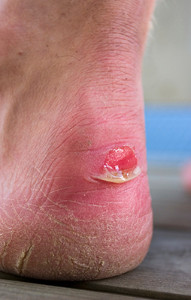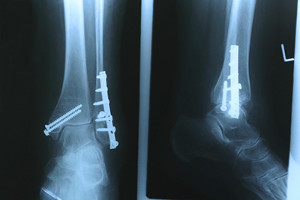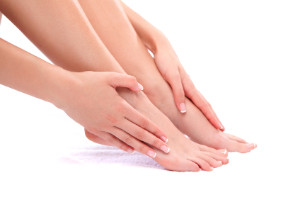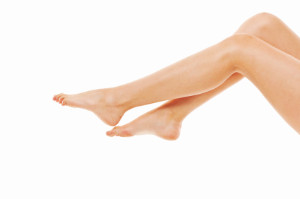Blog
Finding the Right Pair of Shoes For You
 When it comes to shopping for running shoes, there is no perfect shoe that works for everyone. Everyone has a different foot type so just because you’re the same size as someone else, it doesn’t mean their shoe will fit you correctly. Higher prices or brand names also don’t guarantee a great shoe either. There are certain qualities to look for when shoe shopping though. Shoes should be comfortable, especially for long periods of time. Knowing your foot type, such as whether you overpronate or have a neutral foot, can help as well. A podiatrist can help determine your foot type and can also make recommendations about what shoes to wear. A good pair of shoes should provide enough space for your toes, be breathable and comfortable, and support your feet.
When it comes to shopping for running shoes, there is no perfect shoe that works for everyone. Everyone has a different foot type so just because you’re the same size as someone else, it doesn’t mean their shoe will fit you correctly. Higher prices or brand names also don’t guarantee a great shoe either. There are certain qualities to look for when shoe shopping though. Shoes should be comfortable, especially for long periods of time. Knowing your foot type, such as whether you overpronate or have a neutral foot, can help as well. A podiatrist can help determine your foot type and can also make recommendations about what shoes to wear. A good pair of shoes should provide enough space for your toes, be breathable and comfortable, and support your feet.
If you are a runner, wearing the right running shoe is essential. For more information, contact Dr. Kevin Davis from Davis Foot & Ankle Centers. Our doctor can provide the care you need to keep you pain-free and on your feet.
Choosing the Right Running Shoe for Your Foot Type
To increase performance and avoid the risk of injury, it is important to choose the right running shoe based on your foot type. The general design of running shoes revolves around pronation, which is how the ankle rolls from outside to inside when the foot strikes the ground.
- Neutral runners are able to choose from a wide variety of shoes, including minimalist shoes or even going barefoot.
- Runners who overpronate, or experience an over-abundance of ankle rolling, should choose shoes that provide extra motion control and stability.
- Runners who underpronate, or supinate, have feet that have high arches and lack flexibility, preventing shock absorption. They require shoes with more flexibility and cushion.
If you have any questions please feel free to contact our office located in Springfield, TN . We offer the newest diagnostic and treatment technologies for all your foot and ankle needs.
What to Look For When Buying Running or Walking Shoes
 Typically, running shoes are made with considerably heavier cushioning than walking shoes. Fitness walkers have different needs than runners, as walking has much less impact on the feet. One thing to look for when buying running shoes is to make sure the foot can bend in the shoe. Another suggestion is to look for a shoe with a low heel; this can support runners who land on the balls of their feet. Cushioned shoes are favored for those who walk long distances or on hard surfaces. Additionally, shoes that are made from lighter materials will be more comfortable because they are not as heavy.
Typically, running shoes are made with considerably heavier cushioning than walking shoes. Fitness walkers have different needs than runners, as walking has much less impact on the feet. One thing to look for when buying running shoes is to make sure the foot can bend in the shoe. Another suggestion is to look for a shoe with a low heel; this can support runners who land on the balls of their feet. Cushioned shoes are favored for those who walk long distances or on hard surfaces. Additionally, shoes that are made from lighter materials will be more comfortable because they are not as heavy.
For more information about walking shoes versus running shoes, consult with Dr. Kevin Davis from Davis Foot & Ankle Centers. Our doctor can measure your feet to determine what your needs are and help you find an appropriate pair of footwear.
Foot Health: The Differences between Walking & Running Shoes
There are great ways to stay in shape: running and walking are two great exercises to a healthy lifestyle. It is important to know that running shoes and walking shoes are not interchangeable. There is a key difference on how the feet hit the ground when someone is running or walking. This is why one should be aware that a shoe is designed differently for each activity.
You may be asking yourself what the real differences are between walking and running shoes and the answers may shock you.
Differences
Walking doesn’t involve as much stress or impact on the feet as running does. However, this doesn’t mean that you should be any less prepared. When you’re walking, you land on your heels and have your foot roll forward. This rolling motion requires additional support to the feet.
Flexibility – Walking shoes are designed to have soft, flexible soles. This allows the walker to push off easily with each step.
If you have any questions, please feel free to contact our office located in Springfield, TN . We offer the newest diagnostic and treatment technologies for all your foot care needs.
Symptoms of Gout
 If you experience sudden attacks of swelling and severe pain, you may have gout. Gout is a form of arthritis in which small crystals form around the joints and may lead to kidney stones. A buildup of uric acid in the blood leads to inflammation and is the cause of gout. Gout typically affects the toes and ankles, in addition to the knees and fingers.The joints become swollen, and the skin in the affected area may appear red and shiny. Gout occurs in attacks and can be debilitating and extremely painful. Lowering uric acids levels may provide a long-term solution, which is commonly done through change of diet and medication. Ice packs are generally used during an attack for relief. Please consult a podiatrist if you have difficulty walking or have severe pain in your feet.
If you experience sudden attacks of swelling and severe pain, you may have gout. Gout is a form of arthritis in which small crystals form around the joints and may lead to kidney stones. A buildup of uric acid in the blood leads to inflammation and is the cause of gout. Gout typically affects the toes and ankles, in addition to the knees and fingers.The joints become swollen, and the skin in the affected area may appear red and shiny. Gout occurs in attacks and can be debilitating and extremely painful. Lowering uric acids levels may provide a long-term solution, which is commonly done through change of diet and medication. Ice packs are generally used during an attack for relief. Please consult a podiatrist if you have difficulty walking or have severe pain in your feet.
Gout is a foot condition that requires certain treatment and care. If you are seeking treatment, contact Dr. Kevin Davis from Davis Foot & Ankle Centers. Our doctor will treat your foot and ankle needs.
What Is Gout?
Gout is a type of arthritis caused by a buildup of uric acid in the bloodstream. It often develops in the foot, especially the big toe area, although it can manifest in other parts of the body as well. Gout can make walking and standing very painful and is especially common in diabetics and the obese.
People typically get gout because of a poor diet. Genetic predisposition is also a factor. The children of parents who have had gout frequently have a chance of developing it themselves.
Gout can easily be identified by redness and inflammation of the big toe and the surrounding areas of the foot. Other symptoms include extreme fatigue, joint pain, and running high fevers. Sometimes corticosteroid drugs can be prescribed to treat gout, but the best way to combat this disease is to get more exercise and eat a better diet.
If you have any questions please feel free to contact our office located in Springfield, TN . We offer the newest diagnostic and treatment technologies for all your foot and ankle needs.
Causes of Ingrown Toenails
When there is an imbalance in the size of the nail and the enlargement of the skin edge, this may cause an ingrown toenail. Reasons for this may include the nail naturally growing inward, improper shoe fitting, and hereditary conditions. Other causes may be from an improper pedicure and/or poor foot hygiene. Common symptoms can be tenderness of the nail, swelling and redness. Additionally, drainage and pus may occur if there is an infection involved. Home remedies may include soaking the affected toe in lukewarm water, or applying antibacterial ointments for bacterial infections and antifungal ointments for fungal infections. Those who have diabetes or poor circulation are advised to consult a podiatrist even if the symptoms appear to be mild.
Ingrown toenails can become painful if they are not treated properly. For more information about ingrown toenails, contact Dr. Kevin Davis of Davis Foot & Ankle Centers. Our doctor can provide the care you need to keep you pain-free and on your feet.
Ingrown Toenails
Ingrown toenails occur when a toenail grows sideways into the bed of the nail, causing pain, swelling, and possibly infection.
Causes
- Bacterial infections
- Improper nail cutting such as cutting it too short or not straight across
- Trauma to the toe, such as stubbing, which causes the nail to grow back irregularly
- Ill-fitting shoes that bunch the toes too close together
- Genetic predisposition
Prevention
Because ingrown toenails are not something found outside of shoe-wearing cultures, going barefoot as often as possible will decrease the likeliness of developing ingrown toenails. Wearing proper fitting shoes and using proper cutting techniques will also help decrease your risk of developing ingrown toenails.
Treatment
Ingrown toenails are a very treatable foot condition. In minor cases, soaking the affected area in salt or antibacterial soaps will not only help with the ingrown nail itself, but also help prevent any infections from occurring. In more severe cases, surgery is an option. In either case, speaking to your podiatrist about this condition will help you get a better understanding of specific treatment options that are right for you.
If you have any questions please feel free to contact our office located in Springfield, TN . We offer the newest diagnostic and treatment technologies for all your foot and ankle needs.
Blisters and Diabetic Foot Care
 Diabetics need to take proper care of their feet due to their condition. Diabetes often causes poor blood circulation and neuropathy, which causes sensation loss in the extremities and lower limbs. If a diabetic gets a blister on his or her foot, he or she may not even realize it exists. If left unchecked, a blister can become infected and potentially infect the rest of the foot; in worst cases, this may then require amputation. Prevention is key, so wearing well-fitted shoes, conducting everyday foot exams, maintaining proper foot care, and visiting a podiatrist every several months can all help prevent a foot ulcer. If you have a foot ulcer and are diabetic, it is recommended that you see a podiatrist who can provide proper care and attention to the wound.
Diabetics need to take proper care of their feet due to their condition. Diabetes often causes poor blood circulation and neuropathy, which causes sensation loss in the extremities and lower limbs. If a diabetic gets a blister on his or her foot, he or she may not even realize it exists. If left unchecked, a blister can become infected and potentially infect the rest of the foot; in worst cases, this may then require amputation. Prevention is key, so wearing well-fitted shoes, conducting everyday foot exams, maintaining proper foot care, and visiting a podiatrist every several months can all help prevent a foot ulcer. If you have a foot ulcer and are diabetic, it is recommended that you see a podiatrist who can provide proper care and attention to the wound.
Blisters are prone to making everyday activities extremely uncomfortable. If your feet are hurting, contact Dr. Kevin Davis of Davis Foot & Ankle Centers. Our doctor can provide the care you need to keep you pain-free and on your feet.
Foot Blisters
Foot blisters develop as a result of constantly wearing tight or ill-fitting footwear. This happens due to the constant rubbing from the shoe, which can often lead to pain.
What Are Foot Blisters?
A foot blister is a small fluid-filled pocket that forms on the upper-most layer of the skin. Blisters are filled with clear fluid and can lead to blood drainage or pus if the area becomes infected.
How Do Blisters Form?
Blisters on the feet are often the result of constant friction of skin and material, usually by shoe rubbing. Walking in sandals, boots, or shoes that don’t fit properly for long periods of time can result in a blister. Having consistent foot moisture and humidity can easily lead to blister formation.
Prevention & Treatment
It is important to properly care for the affected area in order to prevent infection and ease the pain. Do not lance the blister and use a Band-Aid to provide pain relief. Also, be sure to keep your feet dry and wear proper fitting shoes. If you see blood or pus in a blister, seek assistance from a podiatrist.
If you have any questions, please feel free to contact our office located in Springfield, TN . We offer the newest diagnostic and treatment technologies for all your foot care needs.
Reasons to Have Foot Surgery
 When is comes to podiatric care, podiatrists strive to exhaust all nonsurgical treatment options first. However, there are times and many reasons why people may need foot surgery. Some of these include bunions, which are bony bumps that form on the base of big toe. Surgery may involve straightening the big toe if symptoms continue for a long period of time. Permanently bent toes, also called hammertoes, can be eased by removing the deformed joint between the toes, which improves flexibility. Rheumatoid arthritis can leave the joints in the foot damaged by inflammation. The exact procedure will depend on the severity of this condition, but surgery is commonly performed on the big toe in order to make walking easier. If the ankle is damaged, ankle fusion may be necessary to fuse the talus bone to the tibia, thereby relieving pain in the ankle. Screws are used to hold the bones together, and will heal for 12-14 weeks. Normal shoes can be worn soon afterward and it will be easier to walk. Please consult with a podiatrist to discuss all options when it comes to foot-related conditions.
When is comes to podiatric care, podiatrists strive to exhaust all nonsurgical treatment options first. However, there are times and many reasons why people may need foot surgery. Some of these include bunions, which are bony bumps that form on the base of big toe. Surgery may involve straightening the big toe if symptoms continue for a long period of time. Permanently bent toes, also called hammertoes, can be eased by removing the deformed joint between the toes, which improves flexibility. Rheumatoid arthritis can leave the joints in the foot damaged by inflammation. The exact procedure will depend on the severity of this condition, but surgery is commonly performed on the big toe in order to make walking easier. If the ankle is damaged, ankle fusion may be necessary to fuse the talus bone to the tibia, thereby relieving pain in the ankle. Screws are used to hold the bones together, and will heal for 12-14 weeks. Normal shoes can be worn soon afterward and it will be easier to walk. Please consult with a podiatrist to discuss all options when it comes to foot-related conditions.
Foot surgery is sometimes necessary to treat a foot ailment. To learn more, contact Dr. Kevin Davis of Davis Foot & Ankle Centers. Our doctor will assist you with all of your foot and ankle needs.
When Is Surgery Necessary?
Foot and ankle surgery is generally reserved for cases in which less invasive, conservative procedures have failed to alleviate the problem. Some of the cases in which surgery may be necessary include:
- Removing foot deformities like bunions and bone spurs
- Severe arthritis that has caused bone issues
- Cosmetic reconstruction
What Types of Surgery Are There?
The type of surgery you receive will depend on the nature of the problem you have. Some of the possible surgeries include:
- Bunionectomy for painful bunions
- Surgical fusion for realignment of bones
- Neuropathy decompression surgery to treat nerve damage
Benefits of Surgery
Although surgery is usually a last resort, it can provide more complete pain relief compared to non-surgical methods and may allow you to finally resume full activity.
Surgical techniques have also become increasingly sophisticated. Techniques like endoscopic surgery allow for smaller incisions and faster recovery times.
If you have any questions please feel free to contact our office located in Springfield, TN . We offer the newest diagnostic and treatment technologies for all your foot and ankle needs.
What’s Causing My Heel Pain?
 The heel is comprised of numerous tendons, ligaments, and fatty tissue. Common causes of pain in the heel may include possible stress fractures, bursitis, and obesity, and can typically be treated with ice packs, foot massages, and exercises designed to flex the foot. Probable diagnosis may include plantar fasciitis, heel spurs, and Sever’s disease. Refraining from activities that may have caused the pain not only reduces the stress on the heel, but will help in healing the tendons. This pain is commonly avoided by choosing shoes with laces for a firmer fit, discarding shoes with heels that are worn, and stretching the foot by warming up before a sports related activity. A consultation with a podiatrist is advised in properly diagnosing the cause of the pain, in addition to discovering the best treatment options available.
The heel is comprised of numerous tendons, ligaments, and fatty tissue. Common causes of pain in the heel may include possible stress fractures, bursitis, and obesity, and can typically be treated with ice packs, foot massages, and exercises designed to flex the foot. Probable diagnosis may include plantar fasciitis, heel spurs, and Sever’s disease. Refraining from activities that may have caused the pain not only reduces the stress on the heel, but will help in healing the tendons. This pain is commonly avoided by choosing shoes with laces for a firmer fit, discarding shoes with heels that are worn, and stretching the foot by warming up before a sports related activity. A consultation with a podiatrist is advised in properly diagnosing the cause of the pain, in addition to discovering the best treatment options available.
Many people suffer from bouts of heel pain. For more information, contact Dr. Kevin Davis of Davis Foot & Ankle Centers. Our doctor can provide the care you need to keep you pain-free and on your feet.
Causes of Heel Pain
Heel pain is often associated with plantar fasciitis. The plantar fascia is a band of tissues that extends along the bottom of the foot. A rip or tear in this ligament can cause inflammation of the tissue.
Achilles tendonitis is another cause of heel pain. Inflammation of the Achilles tendon will cause pain from fractures and muscle tearing. Lack of flexibility is also another symptom.
Heel spurs are another cause of pain. When the tissues of the plantar fascia undergo a great deal of stress, it can lead to ligament separation from the heel bone, causing heel spurs.
Why Might Heel Pain Occur?
- Wearing ill-fitting shoes
- Wearing non-supportive shoes
- Weight change
- Excessive running
Treatments
Heel pain should be treated as soon as possible for immediate results. Keeping your feet in a stress-free environment will help. If you suffer from Achilles tendonitis or plantar fasciitis, applying ice will reduce the swelling. Stretching before an exercise like running will help the muscles. Using all these tips will help make heel pain a condition of the past.
If you have any questions please contact our office located in Springfield, TN . We offer the newest diagnostic and treatment technologies for all your foot and ankle needs.
How to Prevent Corns
 Coupled with friction, an excessive amount of pressure on the feet is the most probable cause of corns. Corns can cause the skin to become dry and hardened; the skin’s consistency can also become soft and rubbery, which most often occurs between the toes. Infections can be common for patients with poor circulation or diabetes, and treatment may be necessary to prevent complications. Many options are available for treating corns. Pumice stones are an effective way to remove thickened skin from the foot, though if used incorrectly they can cause damage. The use of foam wedges between the toes may also be recommended to relieve pressure from soft corns. Wearing supportive shoes, preferably with a low heel, may be helpful as well. A consultation with a podiatrist is advised for a diagnosis and assessment of any underlying causes of corns.
Coupled with friction, an excessive amount of pressure on the feet is the most probable cause of corns. Corns can cause the skin to become dry and hardened; the skin’s consistency can also become soft and rubbery, which most often occurs between the toes. Infections can be common for patients with poor circulation or diabetes, and treatment may be necessary to prevent complications. Many options are available for treating corns. Pumice stones are an effective way to remove thickened skin from the foot, though if used incorrectly they can cause damage. The use of foam wedges between the toes may also be recommended to relieve pressure from soft corns. Wearing supportive shoes, preferably with a low heel, may be helpful as well. A consultation with a podiatrist is advised for a diagnosis and assessment of any underlying causes of corns.
If you have any concerns regarding your feet and ankles, contact Dr. Kevin Davis of Davis Foot & Ankle Centers. Our doctor will treat your foot and ankle needs.
Corns: What Are They? and How Do You Get Rid of Them?
Corns can be described as areas of the skin that have thickened to the point of becoming painful or irritating. They are often layers and layers of the skin that have become dry and rough, and are normally smaller than calluses.
Ways to Prevent Corns
There are many ways to get rid of painful corns such as wearing:
- Well-fitting socks
- Comfortable shoes that are not tight around your foot
- Shoes that offer support
Treating Corns
Treatment of corns involves removing the dead skin that has built up in the specific area of the foot. Consult with Our doctor to determine the best treatment option for your case of corns.
If you have any questions please feel free to contact our office located in Springfield, TN . We offer the newest diagnostic and treatment technologies for all your foot and ankle needs.
What is a Podiatrist?
 The feet are the foundation of the body, and the health of your feet play an essential role in your overall well-being. Keeping the feet healthy is critical in maintaining an active lifestyle, so if foot ailments occur, it is advised to seek the medical attention of a podiatrist. These doctors specialize in treating all conditions concerning the foot, including injuries involving tendons and bones, issues caused by diabetes, and foot deformities. Other conditions that are typically treated by podiatrists are ingrown toenails, heel pain, and flat feet. When the disorder is diagnosed, proper treatment will be discussed for long term results, in addition to alleviating pain associated with the problem. Before your initial visit, you may want to comprise a list of concerns you have, as well as questions about the general health of your feet.
The feet are the foundation of the body, and the health of your feet play an essential role in your overall well-being. Keeping the feet healthy is critical in maintaining an active lifestyle, so if foot ailments occur, it is advised to seek the medical attention of a podiatrist. These doctors specialize in treating all conditions concerning the foot, including injuries involving tendons and bones, issues caused by diabetes, and foot deformities. Other conditions that are typically treated by podiatrists are ingrown toenails, heel pain, and flat feet. When the disorder is diagnosed, proper treatment will be discussed for long term results, in addition to alleviating pain associated with the problem. Before your initial visit, you may want to comprise a list of concerns you have, as well as questions about the general health of your feet.
If you are experiencing pain in the feet or ankles, don’t join the stubborn majority refusing treatment. Feel free to contact Dr. Kevin Davis from Davis Foot & Ankle Centers. Our doctor can provide the care you need to keep you pain-free and on your feet.
What Is a Podiatrist?
Someone would seek the care of a podiatrist if they have suffered a foot injury or have common foot ailments such as heal spurs, bunions, arch problems, deformities, ingrown toenails, corns, foot and ankle problems, etc.
Podiatric Treatment
A podiatrist will treat the problematic areas of the feet, ankle or lower leg by prescribing the following:
- Physical therapy
- Drugs
- Orthotic inserts or soles
- Surgery on lower extremity fractures
A common podiatric procedure a podiatrist will use is a scanner or force plate which will allow the podiatrist to know the designs of orthotics. Patients are then told to follow a series of tasks to complete the treatment. The computer will scan the foot a see which areas show weight distribution and pressure points. The podiatrist will read the analysis and then determine which treatment plans are available.
If you have any questions please feel free to contact our office located in Springfield, TN . We offer the newest diagnostic and treatment technologies for all your foot and ankle needs.
Can Exercising Help My Feet?
 Exercises for the feet can be extremely effective in relieving foot pain in addition to preventing possible injuries. Conditions that may benefit from exercise may be plantar fasciitis and Achilles tendonitis. After applying consistent effort, the pain may ease in a few weeks, possibly resulting in much needed relief. An effective stretch for the plantar fascia is to sit while crossing one foot over the knee, pulling the toes back until you feel the muscle stretch. After holding this position for a few seconds, switch to the opposite side. Using a towel that’s wrapped around the ball of your feet while keeping the knees straight and pulling the toes toward the body can be beneficial in stretching the Achilles tendon. Holding this stretch for a few seconds will also stretch out the bottom of the feet. However, before performing any of these stretches speaking with a podiatrist is highly recommended.
Exercises for the feet can be extremely effective in relieving foot pain in addition to preventing possible injuries. Conditions that may benefit from exercise may be plantar fasciitis and Achilles tendonitis. After applying consistent effort, the pain may ease in a few weeks, possibly resulting in much needed relief. An effective stretch for the plantar fascia is to sit while crossing one foot over the knee, pulling the toes back until you feel the muscle stretch. After holding this position for a few seconds, switch to the opposite side. Using a towel that’s wrapped around the ball of your feet while keeping the knees straight and pulling the toes toward the body can be beneficial in stretching the Achilles tendon. Holding this stretch for a few seconds will also stretch out the bottom of the feet. However, before performing any of these stretches speaking with a podiatrist is highly recommended.
Exercising your feet regularly with the proper foot wear is a great way to prevent injuries and build strength. If you have any concerns about your feet, contact Dr. Kevin Davis from Davis Foot & Ankle Centers. Our doctor can provide the care you need to keep you pain-free and on your feet.
Exercise for Your Feet
Exercise for your feet can help you gain strength, mobility and flexibility in your feet. They say that strengthening your feet can be just as rewarding as strengthening another part of the body. Your feet are very important, and we often forget about them in our daily tasks. But it is because of our feet that are we able to get going and do what we need to. For those of us fortunate enough to not have any foot problems, it is an important gesture to take care of them to ensure good health in the long run.
Some foot health exercises can include ankle pumps, tip-toeing, toe rises, lifting off the floor doing reps and sets, and flexing the toes. It is best to speak with Our doctor to determine an appropriate regimen for your needs. Everyone’s needs and bodies are different, and the activities required to maintain strength in the feet vary from individual to individual.
Once you get into a routine of doing regular exercise, you may notice a difference in your feet and how strong they may become.
If you have any questions please feel free to contact our office located in Springfield, TN . We offer the newest diagnostic and treatment technologies for all your foot and ankle needs.

